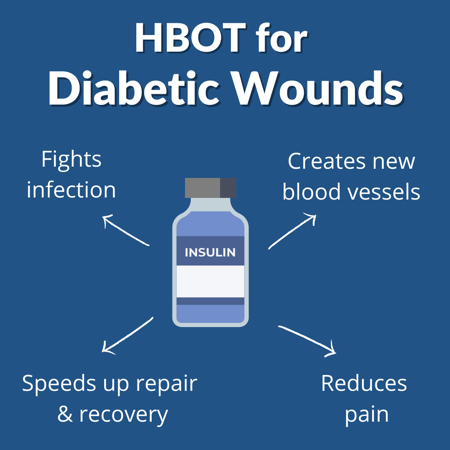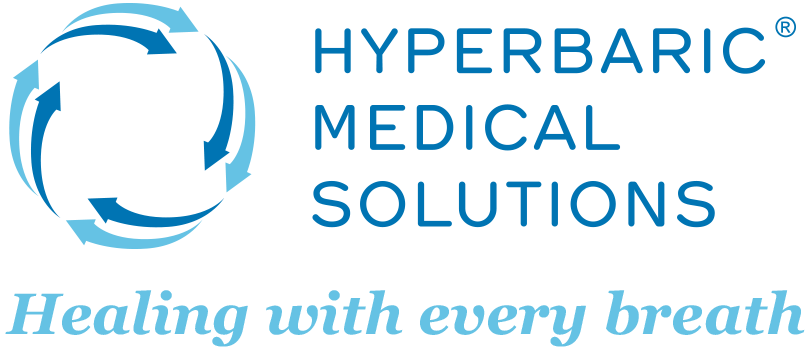Hyperbaric Oxygen Therapy as a Diabetic Foot Ulcer Treatment

Diabetes is a common disease that affects how your body controls blood sugar (glucose). It is approximated that 37.3 million people in the U.S. are living with diabetes and an additional 96 million Americans 18 years of age and older have prediabetes. These numbers are expected to continue to rise in years to come.
Patients with diabetes can sometimes develop problems with their eyes, feet, hearing, heart and kidneys, and other serious medical conditions. Diabetes-related foot ulcers are one of the most common complications that patients with uncontrolled diabetes face. It is estimated that approximately 5% of diabetics will develop ulcers. These are open wounds on the bottom or side of a person’s foot. Not only can these wounds be painful, but they can also lead to infection, gangrene or dead tissue, and/or amputations. Those suffering from diabetic foot ulcers should seek prompt treatment in order to help avoid bad outcomes. Depending on the severity of the ulcer, treatments include antibiotics, foot braces to take pressure off the ulcer, and removal of any dead tissue.
Hyperbaric oxygen therapy (HBOT) is an FDA-approved treatment for diabetic foot ulcers that doesn’t involve drugs, but instead, utilizes the power of pure oxygen.
WHAT HBOT DOES TO THE BODY
Even with the right treatment diabetic foot ulcers can be difficult to heal and may lead to further complications, such as chronic infection or even amputation. If a toe or foot amputation is necessary, such a procedure can significantly alter your life, negatively affecting your mobility and day-to-day comfort. Dr. Alan Katz, national medical director at Hyperbaric Medical Solutions (HMS), explains: "Undergoing HBOT before such drastic measures may decrease the chance of an amputation."
When someone receives HBOT, more oxygen is diffused to the affected tissue. One effect of increased oxygenation is that it reduces swelling and “controls the body’s inflammatory process by regulating cytokines,” Dr. Katz notes.
HBOT can also improve one's response to antibiotics, generate new capillaries, and stimulate the release of the body's natural stem cells, all of which can help to reduce recovery time. HBOT can decrease pain levels, improve your quality of life, and make the management of these non-healing wounds easier.
Some additional treatments include the use of regenerative medicine, Dr. Katz explains, such as “the application of special cell-derived skins, and the use of platelet rich plasma (PRP).”

STUDIES SHOW POSITIVE RESULTS
A randomized, placebo-controlled, clinical trial study, published in Diabetes Care, a journal that shares diabetes-related research, found that “adjunctive treatment with HBOT facilitates healing of chronic foot ulcers in selected patients with diabetes.”
A 2021 study evaluating past clinical studies on hyperbaric oxygen and diabetic wounds, concluded that patients using HBOT had a higher rate of complete healing and lower major amputation rates.
A report in the World Journal of Diabetes shared by the U.S. National Library of Medicine also discusses HBOT as a diabetic foot ulcer treatment. The report says that holistic therapy could reduce "tissue hypoxia, edema, increase angiogenesis and erythrocytes deformability, antimicrobial effects and increase fibroblastic activity.” In other words, HBOT has the ability to increase the amount of oxygen reaching body tissue, which may be able to reduce swelling and inflammation, as well as promote blood vessel growth, prevent bacterial infections, and help heal the wound.
Dr. Katz, who has more than 27 years of experience as a physician and leader in hyperbaric medicine, adds, "The positive results I’ve seen in my career have been significant."
It is important that all diabetics take care of their feet and check for signs of foot ulcers on a daily basis. Symptoms to look out for can include redness, pain, sensation changes, and swelling on the bottom of your feet or blisters. Diabetic foot ulcers can have detrimental effects on your daily living habits so checking for early symptoms can help with identification and earlier treatment.
If you are a diabetic with a foot ulcer or know someone who might benefit from HBOT, schedule a consultation with HMS to learn more. Our professional staff will assess whether HBOT may be helpful, and if so, create a customized protocol—and even suggest other treatments as well—to maximize and optimize your chances of healing.
Because diabetic foot ulcers can have such detrimental effects, it’s important that all diabetics take care of their feet and check for signs of foot ulcers on a daily basis. Early symptoms can include redness, swelling on the bottom of your feet, or blisters.
If you are a diabetic with a foot ulcer or know someone who might benefit from HBOT, schedule a consultation with HMS to learn more. Our professional staff will assess whether HBOT may be helpful, and if so, create a customized protocol—and even suggest other treatments as well—to maximize and optimize your chances of healing.
Learn more about HBOT as a way to heal diabetic lower extremity wounds.
{Updated: March 20, 2023}
Written by Hyperbaric Medical Solutions
Hyperbaric Medical Solutions is a free-standing, independent medical practice, providing hyperbaric oxygen therapy (HBOT). HBOT is an advanced healing therapy that treats conditions that benefit from increased oxygen concentration and absorption in the body....
Read More



